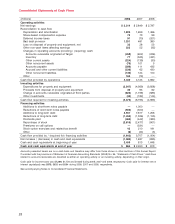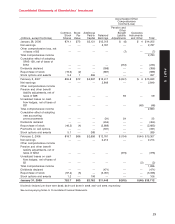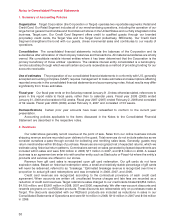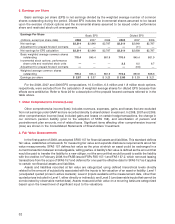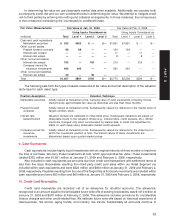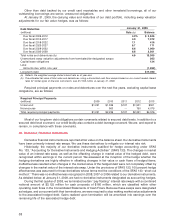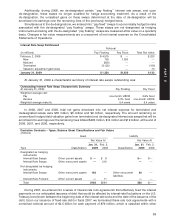Target 2008 Annual Report Download - page 58
Download and view the complete annual report
Please find page 58 of the 2008 Target annual report below. You can navigate through the pages in the report by either clicking on the pages listed below, or by using the keyword search tool below to find specific information within the annual report.
Other than debt backed by our credit card receivables and other immaterial borrowings, all of our
outstanding borrowings are senior, unsecured obligations.
At January 31, 2009, the carrying value and maturities of our debt portfolio, including swap valuation
adjustments for our fair value hedges, was as follows:
January 31, 2009
Debt Maturities
(millions) Rate (a) Balance
Due fiscal 2009-2012 4.3% $ 5,845
Due fiscal 2013-2017 4.0 7,372
Due fiscal 2018-2022 7.1 416
Due fiscal 2023-2027 6.7 171
Due fiscal 2028-2032 6.6 1,060
Due fiscal 2033-2038 6.8 3,501
Total notes and debentures (b) 4.9 18,365
Unamortized swap valuation adjustments from terminated/de-designated swaps 263
Capital lease obligations 124
Less:
Amounts due within one year (1,262)
Long-term debt $17,490
(a) Reflects the weighted average stated interest rate as of year-end.
(b) The estimated fair value of total notes and debentures, using a discounted cash flow analysis based on our current market interest
rates for similar types of financial instruments, was $17,553 million at January 31, 2009.
Required principal payments on notes and debentures over the next five years, excluding capital lease
obligations, are as follows:
Required Principal Payments
(millions) 2009 2010 2011 2012 2013
Unsecured $1,251 $1,336 $107 $1,501 $501
Nonrecourse — 900 — 750 4,075
Total required principal payments $1,251 $2,236 $107 $2,251 $4,576
Most of our long-term debt obligations contain covenants related to secured debt levels. In addition to a
secured debt level covenant, our credit facility also contains a debt leverage covenant. We are, and expect to
remain, in compliance with these covenants.
20. Derivative Financial Instruments
Derivative financial instruments are reported at fair value on the balance sheet. Our derivative instruments
have been primarily interest rate swaps. We use these derivatives to mitigate our interest rate risk.
Historically, the majority of our derivative instruments qualified for hedge accounting under SFAS
No. 133, ‘‘Accounting for Derivative Instruments and Hedging Activities’’ (SFAS 133). The changes in market
value of an interest rate swap, as well as the offsetting change in market value of the hedged debt, were
recognized within earnings in the current period. We assessed at the inception of the hedge whether the
hedging derivatives are highly effective in offsetting changes in fair value or cash flows of hedged items.
Ineffectiveness resulted when changes in the market value of the hedged debt were not completely offset by
changes in the market value of the interest rate swap. Under the provisions of SFAS 133, 100 percent hedge
effectiveness was assumed for those derivatives whose terms met the conditions of the SFAS 133 ‘‘short-cut
method.’’ There was no ineffectiveness recognized in 2008, 2007 or 2006 related to our derivative instruments.
As detailed below, at January 31, 2009, we had no derivative instruments designated as accounting hedges.
During the first quarter of 2008, we terminated certain ‘‘pay floating’’ interest rate swaps with a combined
notional amount of $3,125 million for cash proceeds of $160 million, which are classified within other
operating cash flows in the Consolidated Statements of Cash Flows. Because these swaps were designated
as hedges, and concurrent with their terminations, we were required to stop making market value adjustments
to the associated hedged debt. Gains realized upon termination will be amortized into earnings over the
remaining life of the associated hedge debt.
38


